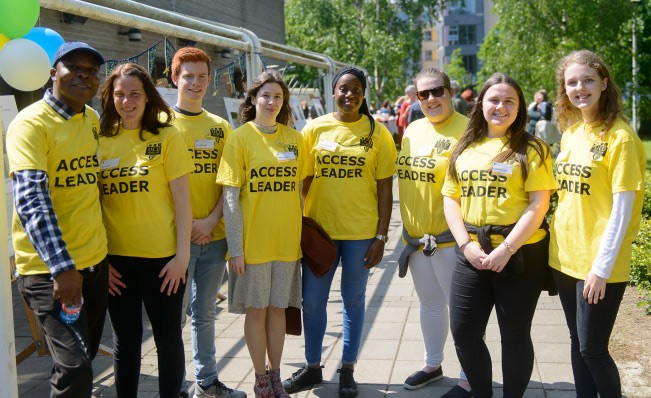Who is the HEAR access route for?
HEAR is for school leavers under the age of 23 as of 1 January 2024 who are resident in the Republic of Ireland. Mature and FET (Further Education and Training) students have their own admissions routes and should contact college admissions offices for more information. Applications to HEAR can only be made online through the CAO.
Additional Information
Click on one of the links below to find out more about HEAR
Eligibility Criteria
HEAR applicants must meet a range of financial, social and cultural criteria to be considered for a reduced points place and extra college support.
If your family income is less than the HEAR Income Limit and you think you may meet a correct combination of the other HEAR indicators, you should consider applying to HEAR. You can find more information about the HEAR Income Limit and the other HEAR indicators below. Here is a list of all the HEAR criteria. Combinations that allow you to take part in the HEAR Scheme are: (Please use the graphic on p.7 of the HEAR handbook pdf)
Criteria 1 and 2, plus one of criteria 4, 5 or 6
Criteria 1 and 3, plus one of criteria 4, 5 or 6
Criteria 1 and 4, plus one of criteria 5 or 6
Criteria 1, 5 and 6
To meet this criteria your family income falls on or below the HEAR Income Limit.
| Number of dependent* children in your family | HEAR Income Limit |
| Fewer than 4 | €46,790 |
| 4 to 7 | €51,325 |
| More than 8 | €55,630 |
Add €4,785 to the total income for every sibling/parent enrolled in a full-time college, university or Post Leaving Certificate further education course.
*A dependent includes:
- A sibling under the age of 16 years on 1 October 2023.
- A sibling over the age of 16 years on 1 October 2023 who is either: attending post primary education.
- Attending a full-time course in FET or higher education.
- Medically certified as permanently unfit for work.
- A parent attending a full-time course in FET or higher education
Please Note: HEAR requires evidence of a full year’s income for 2022 (i.e. 52 weeks). Some applicants depending on their parent(s)’/guardian(s)’ circumstances in 2022 may need to submit Revenue documents and/or evidence of other income as well as evidence of DSP income. Your guardian may not necessarily be your legal guardian, but refers to who you lived with and contributed to the household income in 2022. If you have indicated income from both parents you must submit documents detailing both their incomes. Please go to the Applicant Checklist (click here to get there) for more information about which documents are the right ones for you to submit.
To meet this Indicator, you or your family have to have medical card/ GP visit card that was in date on 31 December 2023.
In order to assess your application, HEAR seeks permission to contact the HSE directly to verify that you or your parent(s) or guardian(s) have a medical card or a GP visit card that is in date on 31 December 2023. You can supply us with the information for yourself or your parent(s)/ guardian(s).
If you have a medical card in your own name, you should enter your own PPS number in Section 3 of the HEAR online application form. If you do not have a medical card/ GP visit card in your own name but your parent/ guardian does, you should enter their name, date of birth and PPS number in Section 3 of the HEAR online application form. Applicants meeting Indicator 2 must meet a combination of 2 other indicators as listed below:
- INDICATOR 1 plus 2 plus 4
- INDICATOR 1 plus 2 plus 5
- INDICATOR 1 plus 2 plus 6
Social Welfare payments are broadly divided into three types: Contributory payments are based on your Pay-Related Social Insurance (PRSI) record. Whether you qualify for a payment depends on having a certain number of PRSI contributions. These types of payments are commonly referred to as Social Insurance payments. Non-contributory payments require you to satisfy a means-test and be an ongoing resident in the State. These types of payments are commonly referred to as Social Assistance payments. Payments and benefits such as Child Benefit and Free Travel do not depend on PRSI contributions or means. Only means-tested social assistance payments count as a HEAR indicator.
The most common means-tested social assistance payments are:
- Carer’s Allowance
- Disability Allowance
- Working Family Payment (WFP) (formerly know as Family Income Support, FIS)
- Jobseeker’s Allowance (JA)
- One-Parent Family Payment (OFP)
- State Pension (Non-Contributory)
Other acceptable means-tested social assistance payments are:
- Back to Work Enterprise Allowance – Self-employed year 2-4
- Back to Work PAYE work
- Deserted Wife’s Allowance
- Guardian’s Payment (Non-Contributory)
- Jobseeker’s Transitional Payment
- Part-Time Job Incentive Scheme
- Pre-Retirement Allowance (PRETA)
- Prisoner’s Wife Allowance
- Blind Pension
- Rent Allowance
- Supplementary Welfare Allowance (SWA)2
- Widow’s or Widower’s (Non-Contributory) Pension
Applicants meeting Indicator 3 must meet a combination of 2 other indicators as listed below:
- INDICATOR 1 plus 3 plus 4
- NDICATOR 1 plus 3 plus 5
- INDICATOR 1 plus 3 plus 6
A socio-economic group (SEG) is a measure of your social background based on your parents’ or guardian’s occupation and employment status. The measure is used by the Central Statistics Office to analyse the social background of the Irish population. Research clearly shows that participation in higher education is not evenly spread across the socio-economic groups. Children of higher professionals, employers, managers, lower professionals, skilled manual workers and farmers are more likely to go on to college than the children of non-manual, semi-skilled and unskilled manual workers. The HEAR scheme is designed to increase the number of students from these under-represented socio-economic groups in third level education.
SEG is coded by an expert company. The SEG is calculated by the responses given in the online HEAR application form to Question 6.
- 6.1 Parent’s/ Guardian’s employment status
- 6.2 Parent’s/ Guardian’s Type of Employment
- 6.3 Parent’s/ Guardian’s Main Job Title
PLEASE USE TABLE HERE: https://accesscollege.ie/hear/making-an-application/eligibility-indicators/socio-economic
Applicants meeting Indicator 4 must meet a combination of 2 other indicators as listed below:
- INDICATOR 1 plus 2 plus 4
- INDICATOR 1 plus 3 plus 4
- INDICATOR 1 plus 4 plus 5
- INDICATOR 1 plus 4 plus 6
Delivering Equality of Opportunity In Schools (DEIS) is an initiative of the Department of Education and Skills aimed at lessening educational disadvantage and bringing about social inclusion in primary and second level education. Traditionally, few students from these schools go on to third level education. Also, children from DEIS schools tend to leave school earlier and do less well academically than students from other schools. Further information on DEIS, including a listing of all DEIS schools, is available on the DES website: www.education.ie.
You must have completed five years in a secondary school that takes part in the DEIS scheme in order to meet this indicator.
The list of schools on the online application includes every second level DEIS school in the country listed as the official school name. HEAR can only assess on the information provided on the online application.
If you attended more than one second level school, you are asked on the online application to enter details of all schools.
Applicants Indicator 5 must meet a combination of 2 other indicators as listed below:
- INDICATOR 1 plus 2 plus 5
- INDICATOR 1 plus 3 plus 5
- INDICATOR 1 plus 4 plus 5
- INDICATOR 1 plus 5 plus 6
There is very strong international evidence that living in a disadvantaged area can negatively affect educational attainment and progression to higher education.
When you apply to HEAR, your address is checked against an index and you are given a score that indicates how disadvantaged your neighbourhood is. To meet this indicator, you must live in an area that is disadvantaged, very disadvantaged or extremely disadvantaged.
HEAR uses information from a deprivation index of relative affluence or disadvantage. The index is based on information gathered in the 2016 Census. The country is divided up into small areas and each area is assigned an average score ranging from extremely disadvantaged up to very affluent. If you are interested in finding out more information about this indicator, please contact your local HEI. To check the classification of your address, please click here to access the Area Deprivation User Guide 2018 prepared by Pobal.
Applicants meeting Indicator 6 must meet a combination of 2 other indicators as listed below:
- INDICATOR 1 plus 2 plus 6
- INDICATOR 1 plus 3 plus 6
- INDICATOR 1 plus 4 plus 6
- INDICATOR 1 plus 5 plus 6
Eligibility Indicators Combinations
To be eligible for the HEAR Scheme, you must meet Indicator 1 Low Income plus a specific combination of two other indicators.
Combinations that allow you to take part in the HEAR Scheme are as follows:
Children in the Care of the State/TUSLA
If you currently are or were in the Care of the State/TUSLA, you should tick yes to Section 4 and you do not need to complete Sections 5 to 7 (ie you will not need to provide . However you must must supply: a letter from TUSLA on TUSLA headed stationery detailing the date you were
taken into care.
A foster child is any child who is looked after by someone else other than the parents, by an order of the court or TUSLA, without a formal adoption of the child by the person.
A separated child is any child under 18 years of age who is outside his/her country of origin and separated from both parents or his/her previous legal primary caregiver.
Carrying forward eligibility
This section is only relevant to applicants who made a HEAR application and were
eligible in 2023 (e.g. applicants who are now repeating the Leaving Certificate). Eligibility for HEAR carries forward for one year provided that you:
- Apply to CAO by 17:00 on 1 February 2024 and indicate that you wish to
apply to HEAR by 17:00 on 1 March 2024. - Supply your correct CAO 2023 application number.
The outcome of your 2023 HEAR application was communicated to you by email in June 2023. If you applied to CAO in 2023 and you were deemed eligible for HEAR in 2023, then your HEAR eligibility can be carried forward to your application for entry in 2024. You must enter your correct CAO 2023 application number in the box provided. You are still required to complete all relevant sections of the 2024 HEAR application form, however you do not need to supply supporting documents as part of your application. You can contact the CAO helpdesk if you require information about your 2023 HEAR eligibility. In the event of being offered and accepting a HEAR place in 2024, you may be required to provide the supporting documents which accompanied your 2023 HEAR application.
Please do not complete this section if you did not apply to or were not eligible for HEAR last year.3

Who is the the HEAR access route for?
Check out this page to find out more are HEAR and to work out if it can help you

How do I apply?
Click here to find out all you need to know about how to make an application
